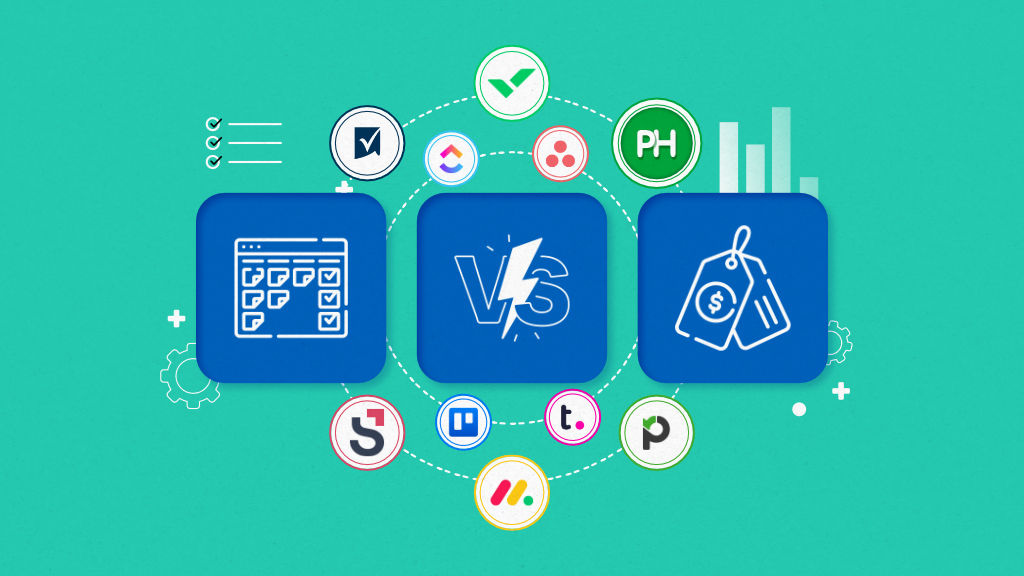Before choosing the right project management software for an organization, stakeholders evaluate and compare the topmost available options. There are at least over 100 project management software solutions in the market with unique strengths and areas of focus. Thus, choosing the project management software that best fits your team’s needs gets difficult.
To make it easy to decide, I have researched, tested, reviewed, and compared 25 most popular project management tools with my team. Based on my observation and analysis, I have shortlisted the best 12 tools to feature on my project management software comparison list.
Along with the features of good project management software, I have kept ease-of-use, learning curve, pricing, and scaling at the core in my comparison. This is because I believe first-time users of project management software need beginner-friendly software that is easy to use, budget-friendly, easy to learn, and scalable.
I have explained for ‘whom’ and ‘what’ each software is “best for”. For example, ProofHub is best for ease of use, Wrike is for advanced dashboards and analytics, and Asana is for workflow automation.
Read this comprehensive comparison and review of top project management software to make an informed decision.
Key features of project management software
Certain features must be present for software to be qualified as project management software. Each software has its own nomenclature of features. That’s why we will look at the top capabilities of project management software for ease of understanding.
- Ability to break a project into tasks and create a project plan: Project management software must allow you to break a project into smaller tasks and subtasks. It is necessary to create a plan for the project. As tasks in a project are interdependent, it should provide you with capabilities like a Gantt chart to plan, set, and manage dependencies.
- Task management: Project management software must provide you with the capability to create, delegate, and track the progress of tasks. This is because the purpose of project management is to complete a project within budget and time. It can happen only when you have control over project tasks.
- Communication and collaboration: Working in a team productively relies heavily on effective and efficient collaboration. Project management software must allow you to communicate with a team in real time and collaborate on shared files.
- Reporting and dashboard: There are multiple stakeholders in a project. Project management software must provide you with the capabilities to create project reports so that you can share progress with stakeholders easily to make quick, data-driven decisions.
- Resource management: Resource allocation and management are a crucial part of project management. Project management software must provide you with the capabilities to view the workload of the resources so that you can easily reschedule the resources to complete a project on time. Calendar, time tracking, timesheets, and resource utilization reports are some of the top features used in resource management.
These are the five must-have function areas that project management software needs to address. You must look for these features when choosing project management software. However, the list of features and capabilities can include integrations, automation, customization, AI assistance, and more.
Project management software comparison chart
| Sr. No. | Tools | Best For | Who Is It For | Pricing |
|---|---|---|---|---|
| 1 | ProofHub | Best for beginners | For growing teams | From $45 per month for unlimited users |
| 2 | Wrike | Best for enterprises | For large teams | From $10 per user per month |
| 3 | monday.com | Best for visual work management | For mid-sized teams | From $27 per month for 3 users |
| 4 | Basecamp | Best for simplified project collaboration | For small to mid-sized teams | From $15 per user per month or $299 per month for unlimited users |
| 5 | ProjectManager | Best for project visualization through Gantt Charts | For medium to large teams | From $14 per user per month |
| 6 | Jira | Best for software development teams | For large teams | From $8.60 per user per month |
| 7 | Asana | Best for integrations and automation | For mid-sized to small teams | From $10.99 per user per month |
| 8 | ClickUp | Best for an extensive set of native features | For large teams | From $7 per user per month |
| 9 | Zoho Projects | Best for end-to-end work management | For small to mid-sized teams | From $4 per user per month |
| 10 | Scoro | Best for project resource and finance management | For small to mid-sized teams | From $26 per user per month |
| 11 | Smartsheet | Best for spreadsheet-based work management | For large teams | From $9 per user per month |
Top 12 project management software review and comparison 2025
Here is my in-depth and detailed project management software comparison:
1. ProofHub: Best for beginners
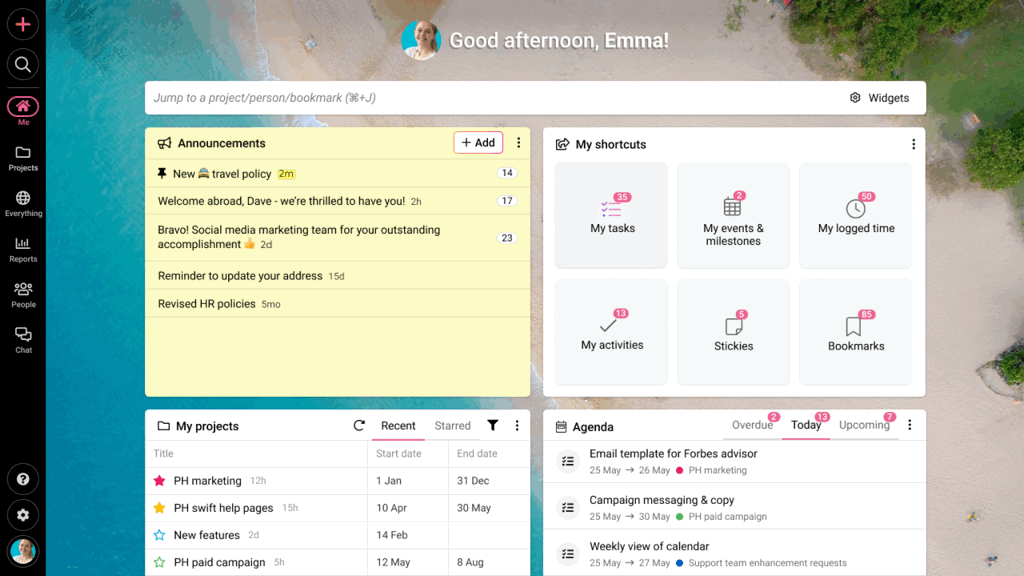
ProofHub is an all-in-one project management and team collaboration tool that brings projects, teams, and documents in one place to work together easily. It allows users to create a project, break it into small tasks and subtasks, and set dependencies to create a project plan. You can delegate tasks, share files, track progress, communicate with team members, and manage resources from a single centralized place. This data centralization to one place brings transparency, builds accountability, streamlines business operations, and improves efficiency.
Why is ProofHub best for beginners?
ProofHub is my choice of tool for beginner and growing teams for two reasons: minimal learning curve and flat-fee pricing.
- Minimal and flat learning curve: The platform has a simple interface with easy-to-navigate architecture. Users of any experience can learn to use the tool at a functional level within a day or two. Even newly joined team members in our organization share the same opinion that they find ProofHub comparatively easier to use and learn than other PM software in the market.
- Flat fee pricing: The platform charges a flat fee. It means unlimited users in the organization can use this tool for a flat monthly price. There is hardly any other project management software in the market that is more competitively priced than ProofHub. This makes it ideal for growing businesses.
“The Most Intuitive, Easy-to-use PM Software with Great Task Management Capabilities. I was quite impressed with how efficiently ProofHub allows project managers to organize and manage all tasks within a project from a single location.” – Jessica R. on G2.com
Key features
- Project hierarchy to break a project into smaller tasks and subtasks
- Centralized task management to create, delegate, and manage tasks
- Gantt chart to set dependencies between tasks and visualize the project plan on the timeline
- Task comments and attachments to collaborate directly on tasks with the team members
- Real-time communication with team members using chat and project discussions
- Track the progress of the task at a glance with multiple project views, including the Kanban board and Table view
- Calendar to visualize and schedule project resources
- Time tracking to track the time spent on tasks
- Timesheets and project reports to overview the project progress and team performance
- Online proofing to review and share feedback on digital assets
- Custom roles and permissions to manage the access of users
- Forms to receive feedback and collect information from external users
- Project templates with custom workflow to help you get started quickly
Pros
- Ease-to-use tool with a simple interface and minimal learning curve
- Integrated notification with email to keep you notified about each change
- Multiple features under one place to replace multiple apps with an all-in-one solution
- Flat-fee pricing allows organizations to add unlimited users at no additional cost
Cons
- There is no suitable plan for solo users
Pricing
ProofHub offers two flat-fee paid plans:
- Essential: $45 per month for unlimited users, up to 40 projects, and 15GB storage, billed annually
- Ultimate Control: $89 per month for unlimited users, unlimited projects, and 100GB storage, billed annually
Ratings
- G2: 4.6/5
- Capterra: 4.6/5
2. Wrike- Best for enterprises
Wrike is a work management solution designed for enterprises. It brings projects, documents, people, and reports to one place to work together effectively.

I found the Wrike architecture similar to ProofHub in my testing. You create a project, add tasks to it, and each task has its dedicated space to collaborate with a team, such as @mentions to tag people, attachments to share files, and proofing to review files. Just like ProofHub, you need to change the status of a task to move it from one stage to another in a workflow designed for the project. However, I recommend Wrike for enterprises.
Why is Wrike best for enterprises?
First, Wrike is too costly for small and medium-sized businesses.
Second, its suite of features is designed for enterprises.
For example, it has ‘customizable dashboards’ that come with advanced analytics and BI to analyze and compare multiple projects across a portfolio.
Similarly, it has ‘advanced budgeting and resource bookings’ to estimate and track financials across all your projects in the portfolio in one place.
In addition to that, the platform also offers enterprise-grade security.
Offering all these features comes at a higher price point.
Also, this extensive range of advanced features makes Wrike difficult to learn. You need to invest in training the team to learn the tool. Enterprises have huge resources to train teams. Thus, Wrike is the best project management software for large companies with extensive resources.
Small and medium-sized businesses with less complex project operations may not need all the advanced features of Wrike. They might need a platform with simple task management, reporting, and tracking capabilities, such as ProofHub.
Key features
- Advanced project resource planning, budgeting, and scheduling capabilities
- Gantt charts to create a project schedule and manage dependencies
- Real-time collaboration with file attachments, cross-tagging, and Wrike Document Editor to corresponding tasks
- Powerful, customizable, real-time dashboards to overview project progress
- Workload charts and real-time reports to manage and reschedule resources
Pros
- Granular administration to control and manage access
- Advanced security features such as 2FA, SSO, and SOC2, ISO27001, and HIPPA compliance
Cons
- Steep learning curve. Requires training for the team members to learn Wrike
- Higher pricing tiers can be expensive for small teams
- Advanced features are reserved for premium plans only
Pricing
Wrike offers five plans:
- Free: With limited features
- Team: $10 per user per month, 2-15 users, billed annually
- Business: $25 per user per month, 5-200 users, billed annually
- Enterprise: Custom pricing, 5 to unlimited users, billed annually
- Pinnacle: Custom pricing, 5 to unlimited users, billed annually
Ratings
- G2: 4.2/5
- Capterra: 4.3/5
Liked Wrike, but not its pricing? Check out top Wrike alternatives!
3. monday.com: Best for visual work management
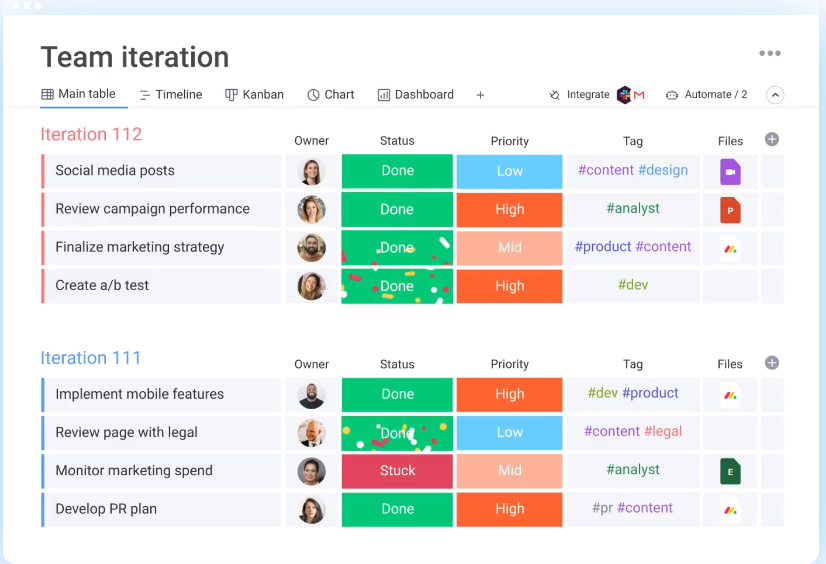
monday.com is a popular work management platform that has made its name for intuitiveness and customization. To manage projects on monday.com, you need to create a board for each project, add tasks and subtasks to it, and use the custom fields to add all the details required to complete a task.
Like Wrike and ProofHub, you can delegate tasks, share files, and view the tasks in multiple views like Gantt and Kanban. Though monday.com does not have real-time chat like ProofHub. It has a discussion space for every task to collaborate with the team on tasks in real-time.
Recently, monday.com has greatly improved its automation and integration capabilities, making it comparable to Wrike for enterprises. It is a great solution for large to mid-sized teams looking for a modern-day, intuitive work management solution.
Why is monday.com best for visual work management?
First, monday.com has a spreadsheet-like interface but is far more intuitive, and second, the platform uses a lot of different colors (I call it colorful software). This makes it easy to visualize progress.
Key features
- Goal & strategy to set company and project-level objectives
- Resource and workload management to visualize resource capacity and plan resources
- Project planning with Kanban, Gantt, and Calendar
- Integration and automation to automate the workflow
Pros
- Highly intuitive interface
- Easy to build automation
Cons
- Learning curve due to a wide range of features
- Limited built-in communication features
- Less flexibility in the pricing
Pricing
monday.com offers five plans:
- Free: $0 for up to 2 users
- Basic: $27 per month for 3 users, billed annually
- Standard: $36 per month for 3 users, billed annually
- Pro: $57 per month for 3 users, billed annually
- Enterprise: Contact sales for pricing
It does not charge you per user. Instead, it charges you for a group of users. The minimum group is 3 users. Custom pricing for more than 40 users in each plan.
Ratings
- G2: 4.7/5
- Capterra: 4.6/5
Read my in-depth review of monday.com!
4. Basecamp: Best for simplified project collaboration
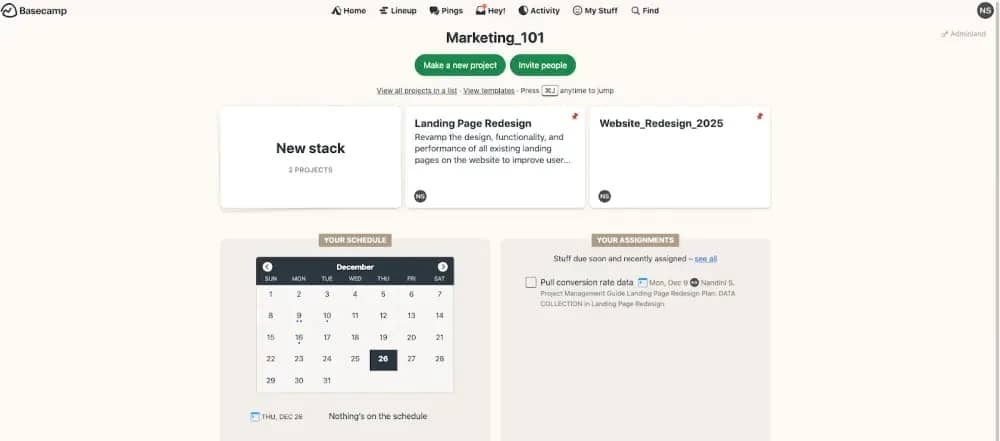
Basecamp is an ideal software choice for teams looking to simplify and streamline project collaboration. It does not come with the complexity of monday.com or Wrike but rather uses simple project pages where tasks, files, discussions, and everything related to the project are present. You can communicate with team members in real time, plan resources, and track the progress with reports.
Why is Basecamp best for project collaboration?
Basecamp creates a project page for each project and adds tools like Message Board, To-Dos, Docs & Files, Chat, and Schedule for each project to simplify and streamline collaboration. Thus, all the data, discussions, and documents of the project are stored in one unified place.
Key features
- Message boards to collaborate with the team and share project plans & updates
- Calendar to plan project’s timelines, milestones, and deadlines
- Chat for one-on-one or small group chats
- Docs & files to share, access, and collaborate on documents
- Basic reports to track progress
Pros
- Easy to use with a minimal learning curve
- Simplify and streamline project collaboration
Cons
- Basic reporting capabilities
- Lack of project planning features
Pricing
Basecamp has three plans:
- Free: Run one project at a time
- Plus: $15 per user per month, unlimited projects, billed annually
- Pro Unlimited: $299 per month for unlimited users, billed annually
Ratings
- G2: 4.4/5
- Capterra: 4.5/5
Read my in-depth comparison of Basecamp vs monday.com!
5. ProjectManager – Best Gantt Chart Software
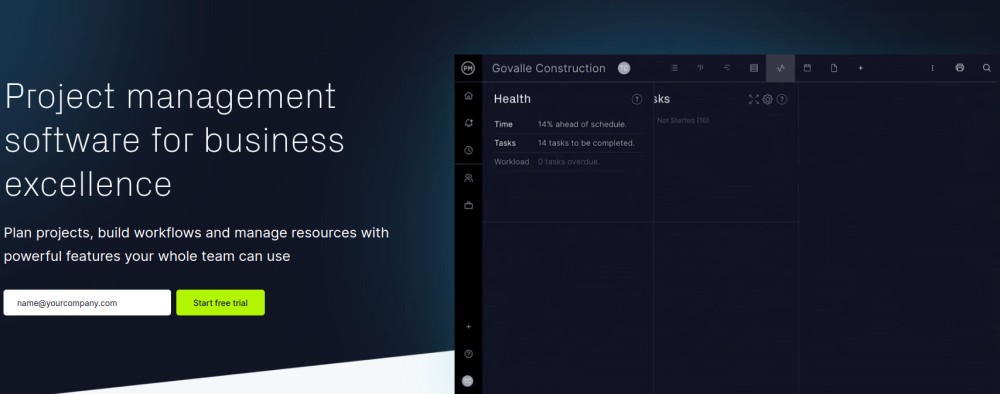
ProjectManager is used by construction, manufacturing, IT, and professional services firms for its advanced Gantt chart capabilities. It offers an intuitive visual interface that makes project timelines, links all four types of task dependencies, and can set a baseline to track progress in real time.
Users find that planning, scheduling, and tracking even complex projects is both simple and powerful with this platform, thanks to the critical path analysis, resource allocation, and cost monitoring capabilities available directly from the Gantt.
As a cloud-based tool, ProjectManager also allows users to see updates in real time, share files, comment at the task level, and stay updated with email and in-app notifications. ProjectManager stands out as the go-to choice for project management professionals who rely on Gantt charts to drive efficiency and deliver results.
Why is ProjectManager best for Gantt charts?
ProjectManager sets itself apart with its advanced Gantt chart features that let users drag and drop tasks, track dependencies, filter the critical path to identify tasks with zero slack, and compare planned versus actual progress—without technical barriers.
The online app is designed to make it easy to update timelines, adjust workloads, and assign new resources from anywhere, in real time. Team members can collaborate directly on the Gantt chart or any of the other project views (sheet, board, list, and calendar) to flag risks, shift priorities, or add milestones, making adjustments effortless whether working in-office or remotely.
Key features
- Drag-and-drop Gantt editing and scheduling
- Task dependencies, critical path, and milestones included
- Import/export with Microsoft Project, Excel, and CSV
- Real-time collaboration and live updates
- Resource allocation, workload, and timesheet tracking
- Multiple project views (kanban, list, sheet, and calendar)
Pros
- Extremely user-friendly Gantt interface
- Strong real-time sync for seamless teamwork
- Flexible integration with major file formats
Cons
- Some advanced reporting tools require higher-tier plans
- Occasional learning curve for complex portfolio features
Pricing
ProjectManager has three subscription plans:
- Team: $14 per user/month billed annually
- Business: $26 per user/month billed annually
- Enterprise: contact sales
Free trial offered to explore tools before buying
Ratings
- G2: 4.4 out of 5
- Capterra: 4.1 out of 5
6. Jira- Best for software development teams
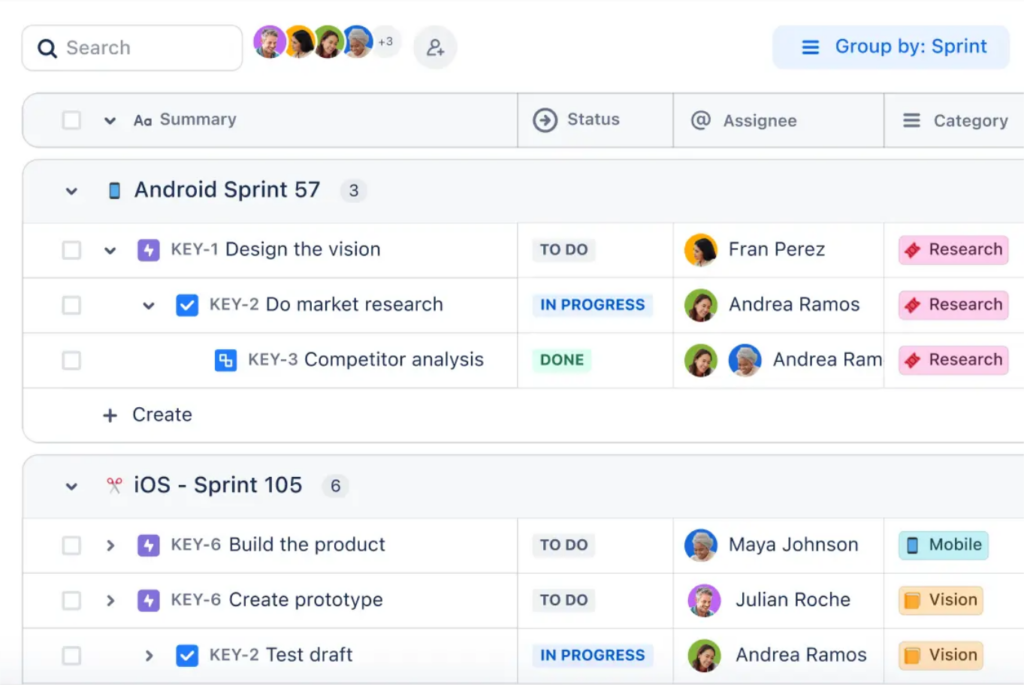
Jira is another work management software designed by Atlassian, but specifically for development teams. It allows you to plan projects, create tasks, delegate to team members, and track progress from a centralized place.
Why is Jira best for software development teams?
The platform offers the best-in-class software development project management capabilities. It is depicted in the entire architecture and every feature of the software.
For example, Jira manages tasks using ‘issues’. An issue is a task space where you can capture all the details of the task you need to complete. Jira allows you to label an issue as a bug, story, or task. Thus, development teams clearly know what type of task they are working on.
Jira has a feature called backlog prioritization. It allows you to prioritize your Project Backlog with ease using ICE, RICE, WSJF (SAFe), or create your custom priority matrix.
Similarly, Jira has Agile Scrum and Kanban boards that directly support Agile project management methodology and its frameworks.
Having said that, it does not mean you cannot use the other software mentioned in the list to manage software development projects. However, if you are a software development company looking for the best cloud project management software, it is highly recommended to use Jira.
Key features
- Scrum and Kanban boards to manage the project work of software development teams
- Issue management to create, prioritize, assign, and track issues
- Timeline to visualize the project plan, roadmap, and responsibilities
- Burn-down charts, velocity charts, and cumulative flow diagrams for data-driven insights into project performance
Pros
- Integrates natively with most third-party apps used by software developers, such as GitHub, VSS, and other CI/CD & testing apps.
- Highly customizable dashboard allowing you to display key metrics and monitor project performance effectively.
Cons
- Steep learning curve. My team member took three days to just explore Jira
- Not an ideal work management solution for non-technical teams
Pricing
Jira offers four plans:
- Free: Free for up to 10 users
- Standard: $8.60 per user per month, billed annually
- Premium: $17 per user per month, billed annually
- Enterprise: Custom pricing
Ratings
- G2: 4.3/5
- Capterra: 4.4/5
Read my in-depth review of Basecamp vs Jira!
7. Asana- Best for integrations and automation
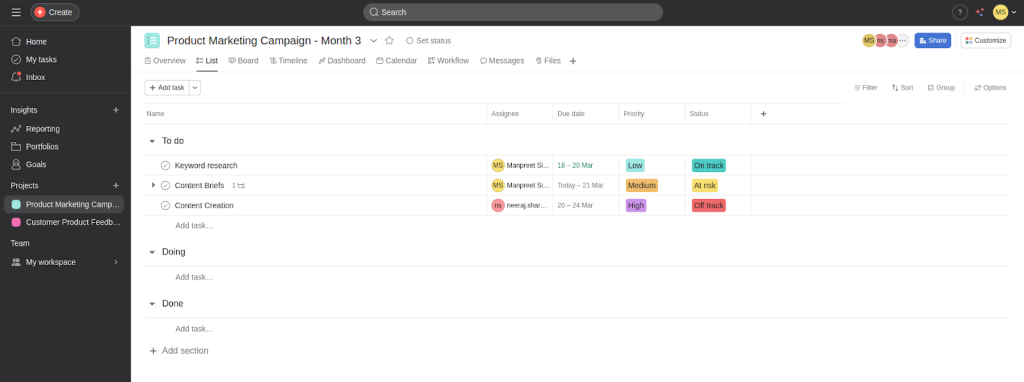
Asana is one of the market’s most well-organized work management software to manage projects, teams, and teamwork from one place. The platform manages the entire work simply: set goals, create projects, collaborate with a team, and track progress.
My first impression of Asana was that it is a platform with a simple, sleek, and formal design. It is designed so that anyone can easily use the most complex features and perform complex actions.
Why is Asana best for integration and automation?
First, Asana comes with an extensive library of templates. These templates come with built-in integrations with third-party apps. It makes it easy to manage the work. Second, an extensive list of pre-built rules allows you to build automation within seconds.
Key features
- Set goals at the company, project, team, and personal levels
- Multiple project views, including board and timeline to visualize progress
- Reporting to provide an overview of the project progress
- Portfolios to help you visualize and manage projects
- Message to communicate with the team on projects
Pros
- Formal and simple interface
- Highly organized platform and easy to use
Cons
- More expensive than other PM software in the market
Pricing
Asana offers three plans:
- Personal: Free up to 10 team members, but without automation and AI
- Starter: $10.99 per user per month, billed annually
- Advanced: $24.99 per user per month, billed annually
Ratings
- G2: 4.4/5
- Capterra: 4.5/5
Read more: 11 Best Asana alternatives & competitors for project management
8. ClickUp- Best for an extensive set of native features
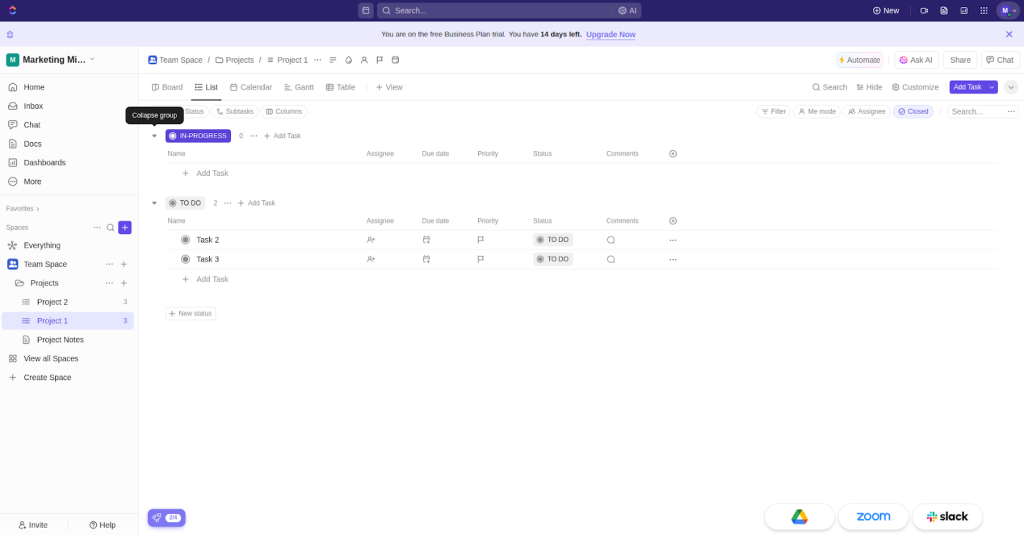
ClickUp is a task management software with the most extensive set of features. It allows you to plan projects, manage tasks, track progress, collaborate with team members, and much more to improve productivity.
My first impression of ClickUp was that it was completely the opposite of Asana. The interface was quite complex, cluttered, and filled with endless features. ClickUp knows this thing very well. That’s why the platform prompts the option to place a call to help you with the onboarding. The platform also has a lot of training videos to help you learn the tool.
Why is ClickUp best for an extensive set of native features?
ClickUp offers everything you need natively to manage work, such as tasks, chat, Gantt chart, dashboards, whiteboard, proofing, docs, reports, and time tracking.
Key features
- Clear project hierarchy- Space, Folder, List, Tasks, Subtasks, and Checklists- to plan projects and organize tasks
- Multiple project views to view progress from different angles
- A suite of collaboration tools such as Chat, Comments, Whiteboards, Docs, and proofing
- ClickUp AI to help you create, analyze, and summarize content
Pros
- An extensive library of templates to help you get started quickly
- A vast range of features in one place at a competitive price
Cons
- Complex interface and steep learning curve
- Slow loading speed
- Priority support is reserved only for the enterprise plan
Pricing
ClickUp offers four plans:
- Free: Free for small teams, with basic features and limited storage
- Unlimited: $7 per user per month, billed annually
- Business: $12 per user per month, billed annually
- Enterprise: Custom pricing
Ratings
- G2: 4.7/5
- Capterra: 4.6/5
9. Zoho Projects: Best for end-to-end work management
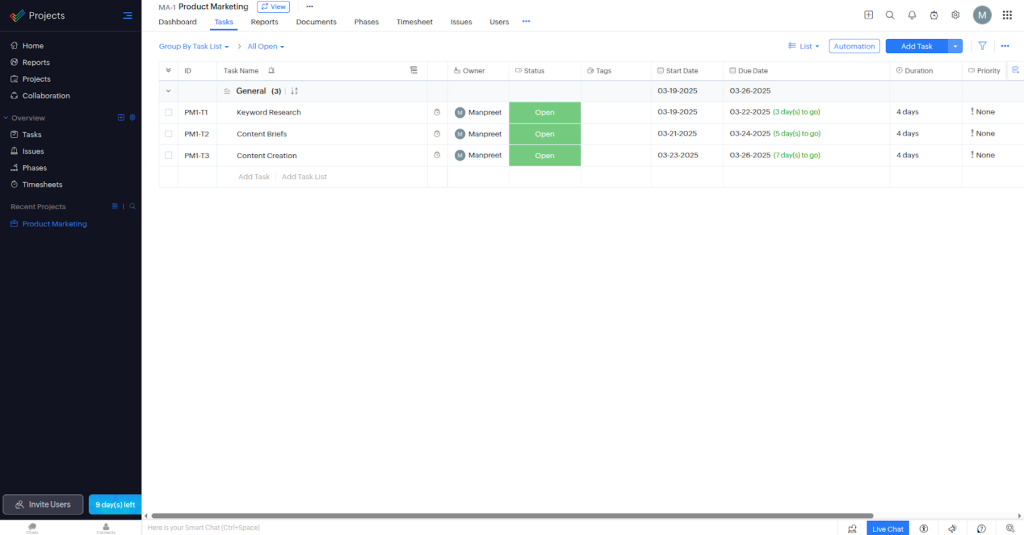
Zoho Projects is a feature-rich project management software that manages projects and facilitates team collaboration. The platform offers a similar set of features to ClickUp, but with a better interface. This is because the platform takes a different approach to work management. It uses the Zoho suite of apps to help perform advanced operations rather than cluttering the platform with features. This makes the Zoho experience better.
Why is Zoho Projects best for end-to-end work management?
Zoho Projects has a vast suite of apps in the following categories: Sales, Marketing, Commerce and POS Service, Finance, Email and Collaboration, Human Resources, Legal Security and IT Management, BI and Analytics, and Project Management. This ensures that you do not need any other app outside the Zoho ecosystem.
Also, Zoho is cheaper than other project management software in the market for the value it offers. Thus, it is an ideal choice of project management software for small businesses that need an end-to-end work management solution from scratch.
Key features
- Gantt charts to create a project plan, break a project into tasks, and set dependencies between tasks
- Task management to create, delegate, and manage tasks
- Time tracking to log every minute of billable and non-billable hours to timesheets
- Task automation helps you automate tasks or actions in a workflow
- Integrate with the Zoho suite of apps for end-to-end work management
Pros
- End-to-end work management solution
- High value for money
Cons
- Slow loading speed and buggy integration with other apps
- Tech support can be improved
Pricing
Zoho Projects offers three plans:
- Free: For up to three users
- Premium: $4 per user per month, billed annually
- Enterprise: $9 per user per month, billed annually
Ratings
- Capterra: 4.4/5
- G2: 4.3/5
10. Scoro: Best for project resource and finance management
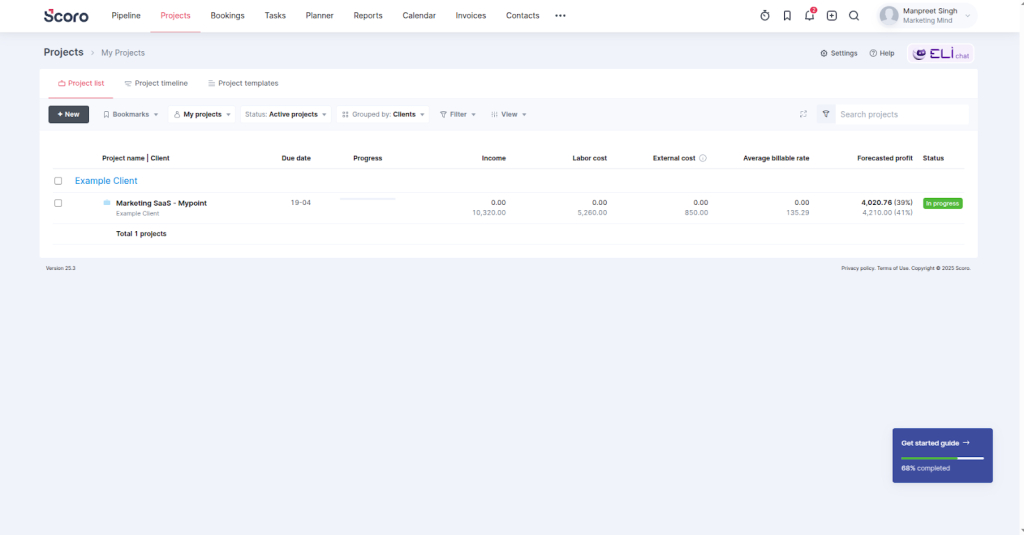
Scoro is a project management software that helps you take control of your finances. It helps you manage a project’s finances with four simple steps: create a quote for the project, plan and book resources, create tasks and track progress, and issue invoices. Every task is tracked, billed, and accounted for.
Why is Scoro best for project resource and finance management?
Most of the project management software offers basic built-in budgeting, resource planning, and invoicing capabilities and relies on third-party apps for time tracking, budgeting, and invoicing.
However, Scoro comes with an advanced level of resource management and billing features and is designed for these functions. For example, you can define the charges of the resource based on the role.
Also, you can plan the resource capacity based on availability using advanced workload charts and percentage allocation.
Like this, it has a suite of features oriented towards budget and resource management.
Thus, it is an ideal project management software for agencies that need advanced project finance and resource management capabilities.
Key features
- Quotes to estimate project costs and convert them into projects
- Booking to visualize resource capacity and book your team
- Task management to collaborate on tasks with team members
- A planner to visualize projects on the calendar
- Time tracker to track time spent on tasks, and invoices to convert tracked time into invoices automatically
Pros
- Integrates project management with financial tracking
- Manage contacts, leads, and deals in one place with Pipeline
Cons
- Comes with a steep learning curve
- Pricing is not suitable for small businesses
Pricing
Scoro offers four paid plans:
- Core: $19.90 per user per month, billed annually
- Growth: $32.90 per user per month, billed annually
- Performance: $49.90 per user per month, billed annually
- Enterprise: Custom pricing
Ratings
- Capterra: 4.6/5
- G2: 4.5/5
11. Smartsheet – Best for spreadsheet-based work management
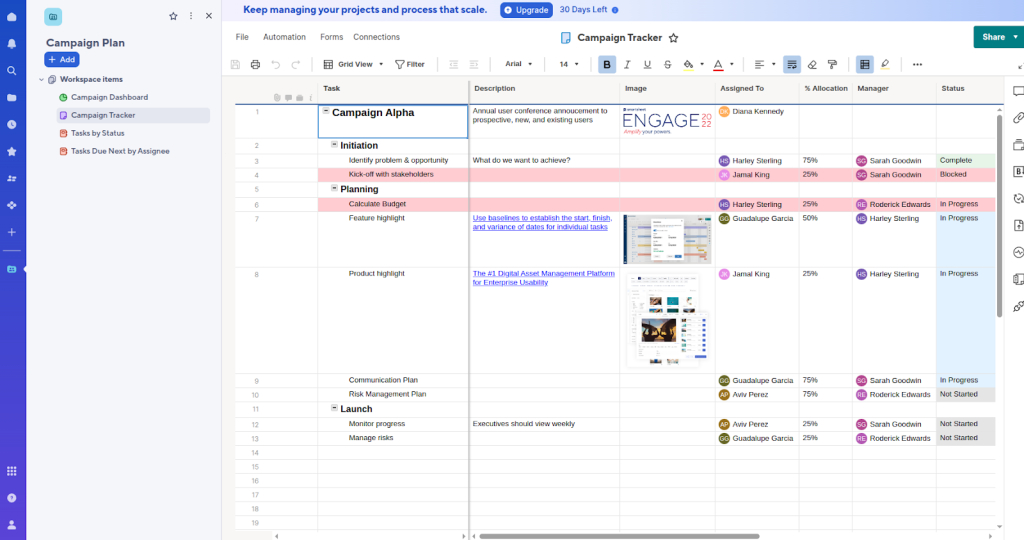
Imagine spreadsheets with superpowers, and you have a Smartsheet! Smartsheet is an enterprise-grade, highly customizable work management platform that helps you plan, manage, and track the projects of the entire organization from a single place. The platform has a similar interface to the spreadsheets but offers advanced features such as automation, resource management, a dashboard, reporting, and collaboration.
Why is Smartsheet best for spreadsheet-based work management?
The interface of Smartsheet is similar to that of spreadsheets. It manages work using rows and columns. For example, when you comment on a sheet, it mentions the row and the tagged task. You have options for rich-text formatting.
Key features
- View all workspaces in one place to easily access projects
- Dashboard and reports to view project status using various data points
- Conversation to mention people on the sheet to collaborate
- Workload tracking and resource management to identify workloads and allocate resources
- Admin controls, custom roles, and permissions to manage access
- Automation to automate workflows
Pros
- Built-in templates to get started with project management
- Customizable dashboards and reports for real-time insights
Cons
- It comes with a steep learning curve
- Need to purchase add-ons or upgrade to paid plans for advanced features such as workload tracking, unlimited automation, and time tracking
Pricing
Smartsheet offers three paid plans:
- Pro: $9 per user per month, billed annually
- Business: $19 per user per month, billed annually
- Enterprise: Contact the sales team
Ratings
- Capterra: 4.5/5
- G2: 4.4/5
12. Teamhood – Best for Kanban-based task management
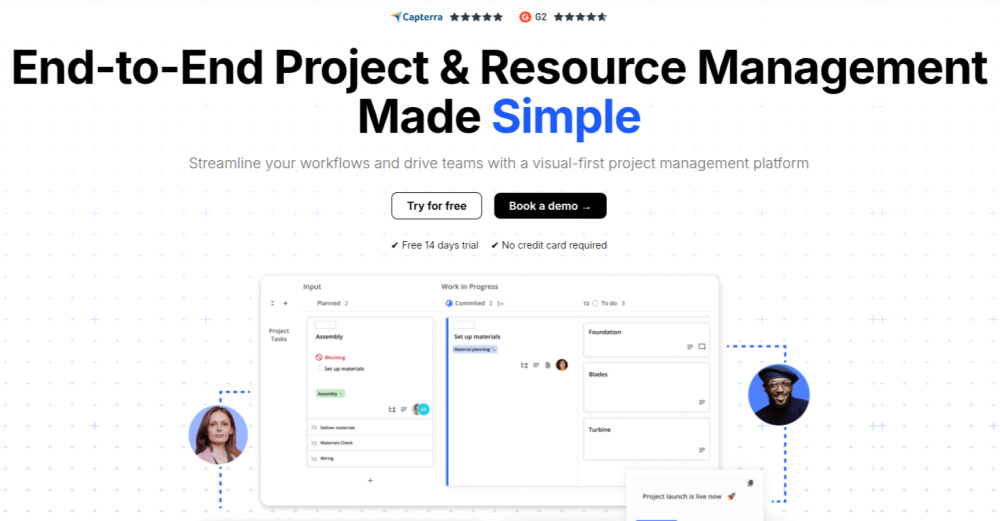
Teamhood is a visual project management platform designed for teams that prefer visual workflow management with Kanban boards. It allows you to create visual workflows, manage tasks with drag-and-drop simplicity, and track time spent on work, all from an intuitive board-based interface. The platform focuses on clarity and simplicity, making it easy for teams to visualize their entire workflow for each process and stay aligned on project priorities.
Why is Teamhood best for Kanban-based task management?
Teamhood stands out for its highly customizable Kanban boards that can be tailored to match any team’s workflow. It lets you create unlimited swimlanes, customize columns to reflect your unique process stages, and add custom fields to capture exactly the information you need. The visual nature of the platform makes it instantly clear who’s working on what and where bottlenecks exist, while the flexibility ensures it adapts to your workflow rather than forcing you to adapt to the tool.
I found Teamhood’s visual approach to project management suitable for our team to see the big picture while staying on top of individual tasks. The customization options are endless, but you need to have full process maturity and understanding of the process before creating a board for that process.
Key features
- Highly customizable Kanban boards with unlimited swimlanes and columns
- Task cards with attachments, checklists, comments, and custom fields
- Gantt charts for project roadmap planning
- Time tracking is integrated directly into task cards
- Workload management to balance resources across projects
- Real-time collaboration with team members through comments and @mentions
- Board templates to standardise workflows across teams
- Dashboard and reporting for project insights and team performance
Pros
- Intuitive visual interface with minimal learning curve
- Highly flexible and customizable to match any workflow
- Affordable pricing for small to mid-sized teams
- Clean, distraction-free interface focused on what matters
Cons
- Limited advanced features compared to general project management tools
- Primarily board-focused, with fewer list or table view options
- The integrations library is very limited
Pricing
Teamhood offers several plans:
- Personal: free for small teams
- Team: from €9.00 per user per month, billed annually
- Business: from €18.00 per user per month, billed annually
- Enterprise: custom pricing available
Ratings
- Capterra: 5/5
- G2: 4.7/5
I hope this comparison of the 12 best project management software helps you make an informed decision.
How to choose the right project management app for your business?
Every organization has unique needs and requirements. Therefore, it is very important to consider the following factors while choosing the right project management app for your business:
- Features: Create a list of the features you need. Software should provide you with the following basic capabilities: project planning, task management, project reporting, team collaboration, and stakeholder management. Apart from that, look for additional features and capabilities you need in project management software, such as budgeting, automation, or integration with a specific app your company uses.
- Ease of use and learning curve: The software should be easy to use and learn, especially if your team is using project management software for the first time. Look for easy-to-learn-and-use software with a minimal & flat learning curve and an intuitive & simple user interface.
- Pricing & scalability: The biggest problem with project management software is that they do not scale cost-effectively. Look for software that fits within the budget and scales cost-effectively. Choose the software that offers the best value for money and is suitable for your team size.
- Security: The software should follow the industry-standard data security protocols. It ensures your data is safe and protected. Common security standards include TLS/SSL and AES Encryption for data and data transfer security, SOC 2 certification for robust security practices, and single sign-on (SSO) and multi-factor authentication (MFA) for authorized access.
- Reviews & free trial: Before making a final decision, read the user reviews on independent websites like Gartner, PCMag, G2, Capterra, and Forbes. It helps you gather insights on ease of use, customer support, and overall satisfaction. Enroll in a free trial to get hands-on experience with the software and make a final decision.
Pricing plan comparison of the 12 best project management software
| Sr. No. | Tool | Pricing Plans | Free Trial |
|---|---|---|---|
| 1 | ProofHub |
| Free 14-day trial |
| 2 | Wrike |
| Free 14-day trial |
| 3 | monday.com |
| Free 14-day trial |
| 4 | Basecamp |
| Free 30-day trial |
| 5 | Trello |
| Free 14-day trial |
| 6 | Jira |
| Free 7-day trial |
| 7 | Asana |
| Free 14-day trial |
| 8 | ClickUp |
| Free 14-day trial |
| 9 | Zoho Projects |
| Free 10-day trial |
| 10 | Scoro |
| Free 14-day trial |
| 11 | Smartsheet |
| Free 30-day trial |
Why is ProofHub the best choice for your team?
There are two reasons ProofHub can be the best choice of software for your team out of all the tools in the project management software comparison:
- It is easy to use and learn
- It allows unlimited users for a flat price. No need to pay a per-user fee
Project teams using project management software for the first time or switching from emails and spreadsheets need project management software that is easy to use and learn. ProofHub comes with almost no learning curve. Users of any level of experience can learn to use the tool at a functional level within a matter of hours.
Second, growing businesses do not want to escalate operational costs too much. ProofHub comes with two flat-fee paid plans that allow organizations to onboard as many users as they want without paying any additional fee. Most other tools charge per user. Thus, with ProofHub, you can keep the operational costs low.
With all the project management and team collaboration capabilities in a single place and a similar software architecture to other best project management software, ProofHub makes an ideal choice of tool for beginners and growing teams.
Frequently asked questions
1. What is project management software?
Project management software is a work management and collaboration platform that helps teams plan, organize, track, and execute projects efficiently. It provides features like project planning, task management, team collaboration, resource allocation, and project reporting to manage a project. Industries across the globe use these tools to ensure projects are completed on time and within budget.
2. What are the benefits of using project management tools?
Project management tools enhance work efficiency by centralizing tasks, deadlines, and communication. The top benefits of PM software include improved collaboration, real-time progress tracking, better resource management, and reduced manual errors. They also provide data-driven insights, automate repetitive tasks, and ensure accountability, helping teams meet goals faster while maintaining stakeholder transparency.
3. What are the upcoming project management software trends?
The most popular trend in project management is the use of AI. AI is used for brainstorming, content ideation, project planning, workflow automation, and data. Apart from that, low-code/no-code customization is also rising. Additionally, a focus on real-time collaboration and cybersecurity will shape the future of project management software.
